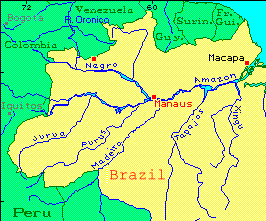

Common Name: Neon Tetra
Scientific Name: Paracheirodon innesi (Myers)
Categories: Order: Cypriniformes; Suborder: Characoidei;
Family: Characidae
Origins: It is from the Amazon region, western Brazil, Colombia and
northern Peru; at Iquitos in the Upper Amazon, in it's tributaries, and in
the Putumayo and Purus. Most fish available today are tank bred.

Description: It has a greenish-olive background with a metallic blue
stripe that runs from it's nose to the adipose fin. The back underside of
the body is a bright red from the ventral fin extending back to the caudal
fin. The remainder of the underside is silvery. The fins are without color
with the exception of the anal fin which it's first rays are a milky white.
It grows to 1 1/2 inches (4 cm.) long. The belly appears concave in the males,
and rounded in the females. Note: They are susceptible to a specific
Neon disease (Plistophora), which is difficult to treat.
Diet: Dry/Vegetable/Live
Environment: Neons do best in subdued light, with a dark substrate
and a water temperature between 70-73F. (21-23 C.). Thick edge and background
plants in which chased fish can hide, (fine-plumed plants are possible).
Tank Mates: Species or community tank with a side length of at least
24 inches (60 cm.). Keep in a school of no less then 7; schools of 15-20
are even better.
Breeding: Only young fish that have just reached sexual maturity (9-12
months old) should be used for breeding. The water should not be allowed
above 75F. (24C.), extremely soft (1-2 DH) and slightly acid (pH 5.5-6.0).
A good spawning substrate is Myriophyllum bunches. Use a small, 4 to 5 1/2
gallon, all glass tank. This species is not particularly productive. The
parents should be removed from the tank after spawning. The clear, hyaline
eggs barely stick to the plants in which they were laid. They hatch in 22
to 26 hours and become free swimming in about 4 days. Gradually introduce
the fry to new slightly harder water during rearing. If not, they will tend
to die.
A post from one of the aquaria newsgroups
Subject:
Date: Mon, Jul 27, 1998 22:30 EDT
From: PSO777
Message-id: <1998072802300500.WAA01271@ladder03.news.aol.com>
There has been a noticeable uprise in the fatality rate in neons over the past several months due to an out break in their native habits. This info has not been respectfully posted to the public.
Neon Tetra disease is caused by a protozoan spore that causes tumor like
cysts in the muscle tissue. For the neon there are no external symptoms death
comes rapidly but for other fish the processes is some what slower and some
external symptoms may appear. When the cyst becomes inflamed to the point
of rupturing the muscle it will swell the body and cause the scales to raise,
this symptom is often confused with Dropsies. Along side of this illness
other secondary illness may become apparent. Although some of these symptoms
are curable, no successful treatments for NTD has been found yet.
Research is being done know so that the public can be warned of this. If
you have been having problems with neons or any other fish that have been
exposed to neons, please e-mail me a letter of full detail. Tank set up,
number and type of fish, how many neons still survive and other symptoms.
This will be greatly helpful in our research in hopes that a cure can be
found.
Before buying any neons, ask the store about their condition. keep
them separate from all other fish Including any tools that you use for upkeeping.
NTD is highly contagious and is fatal.